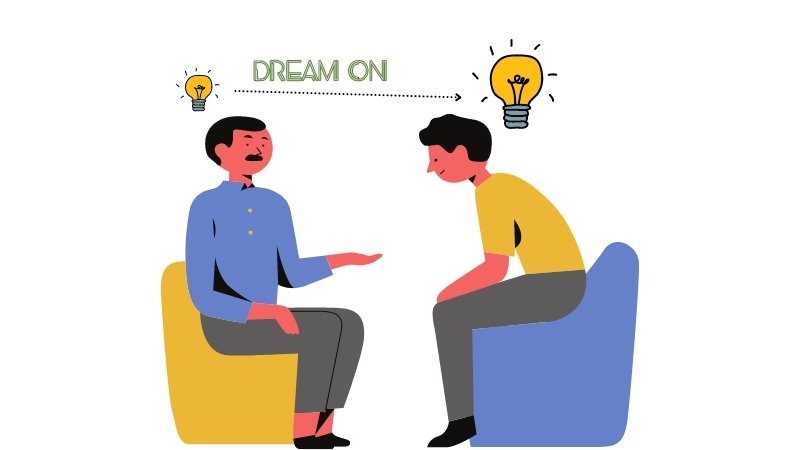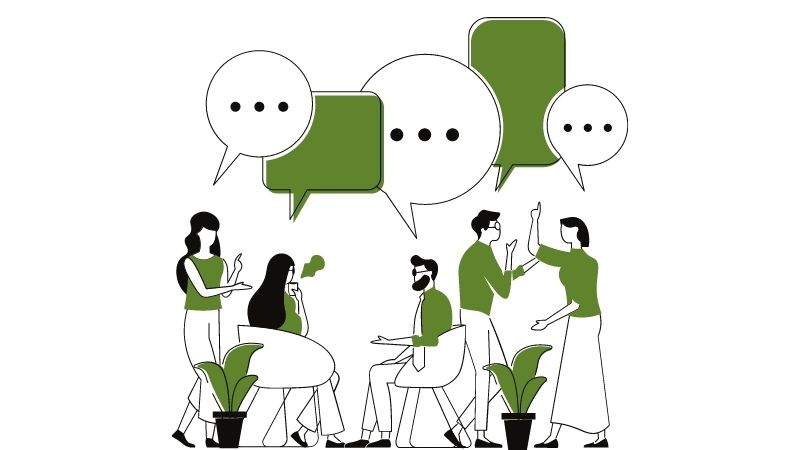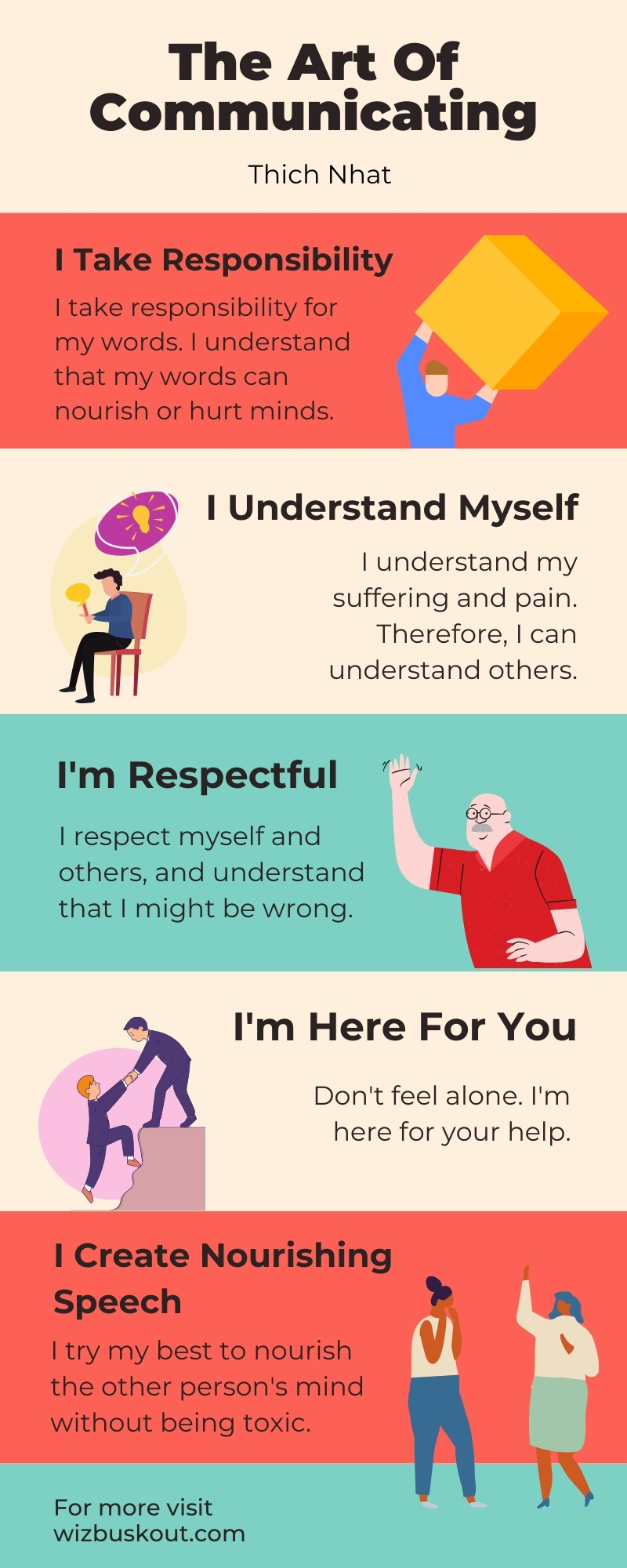The Art Of Communicating by Thich Nhat is a guide to learning the art of effective communication. It is based on the idea that communication is food for the mind and simple words uttered by us can either nourish or hurt the mind of the other person.
The Art Of Communicating Summary (PDF)
Having relationship problems?
Want to improve your communication skills and impress anybody?
Want to understand people’s pain better?
You are in the right place.
In this summary, you’ll learn how you can nourish people with your words. And reduce the pain and suffering in the world.
Alright, so without wasting any time, let’s get started.
Best Tools for Bibliophiles
- Listen to your Favorite Books on The Go: Try Audible and Get Up To 2 Free Audiobooks | Get 3 Free Audiobooks
- Read over 2 million e-books on any device: Sign up for 30 days free trial of Kindle Unlimited and read your favorite titles.
- Get free 2-day shipping of your favorite books and stream premium TV shows on Amazon Prime: Sign up for 30 days free trial of Amazon Prime.
- I use Notion to take reading notes, plan everything, and run all my businesses. (Notion is my Second Brain 🤯): Get Notion for free for personal use (paid for teams/businesses)
Key Lesson #1: Communication is food for the mind

Just like our body needs food, our mind also takes inputs.
Mind is a non-stop machine that keeps producing thoughts.
But to produce thoughts, the mind requires memory.
Thoughts can’t come out of thin air.
We usually think that the mind is in some other dimension and it’s a special thing with special rules.
But if you study about it, you’ll find that it pretty much acts like our body.
Just as our body needs exercise to stay fit, our minds also need mental workouts to stay healthy.
If our mind is not at ease, it can create problems in life.
Every word you read, listen, or speak is food for your mind.
And reading, speaking, and listening come under communication.
Communication is a crucial thing in our lives.
Without communication, we can’t survive.
Most people think that communication is only through words.
But it’s wrong. You can communicate even without doing anything.
The way you present yourself, the things you do, all communicate something about you.
That means:
You are always communicating.
What’s more?
You don’t even need another person to communicate.
Most people think that you can’t communicate without another person.
But the reality is:
We are always communicating with ourselves.
Just watch your thoughts right now.
The conversation that you do with yourself is also a type of communication.
What are your thoughts? Your thoughts are simply words you speak to yourself.
And what you say to yourself is also food for your mind.
The words you feed your mind ultimately affect how you think. They shape your beliefs and influence your worldview.
The question is:
Would you feed yourself unhealthy food ever?
Nobody in the right mind would do that, right?
We must eat healthy food to live longer.
Although we take care of our bodies by eating nutritious food, we often tend to forget our minds.
Our mind is similar to our body. Although the body is material, the mind can’t be seen with eyes.
So we tend to ignore it and say, “Everything is going to be alright.”
We never take responsibility for our minds.
What’s worse: We even feed unhealthy stuff to our minds.
Remember, every word that penetrates your mind becomes its food.
So it’s your duty that you allow the right food to enter your mind.
Now here is the thing:
Most people who realize that their mind also needs food forget that other people also have a mind.
The author says that we should never use toxic words that may harm other people’s minds.
Often when we are angry, we spit out toxic words that make both us and the other person unhealthy.
And increases suffering.
Sometimes, we let in too much negativity through various channels like social media, television, etc.
When you speak, you must realize that what you say will become food for the people involved in the communication.
These days, you can’t avoid communication at all.
So you must learn how to do it the right way.
You must learn the art of communicating with compassion and empathy.
In fact, communication is so valuable that it can transform your bad relationships into healthy and nourishing ones.
Good communication can take your career to the next level — even when you have an angry whimsical boss.
Remember, words are food for your mind. It’s hard to survive without feeding the right words to your mind.
Be extra careful what you feed your mind.
One toxic word can destroy your peace of mind and drain away all your energy.
Sometimes, they can even make your life miserable.
Hopefully, in this summary, you are going to learn how to avoid toxic communication and use your words to nourish people with compassion and love.
And uplift them.
Yes, yourself too.
Keep reading to learn more.
Reading is also communication.
So right now, you are having healthy communication.
Congrats!
Key Lesson #2: Learn to communicate with yourself to be able to communicate with others better

The first conversation starts with yourself.
Who is the one person you talk with the most?
You might take some names of your friends or family members, but sorry, you are wrong.
You are the one that you talk the most with.
How?
Simply count the number of thoughts you produce every single day.
It’s crazy:
We talk so much and we don’t even realize it.
Okay — so everybody talks so much.
Talking so much doesn’t imply that you are a good communicator.
So we have to learn the art of self-communication step-by-step.
The author has made it simple in this book.
He says that we should be able to listen and talk to our bodies and minds separately.
To talk with your body, you have to watch your breath.
And to talk with your mind, you have to watch your thoughts.
Sound simple, right?
Well, it’s not.
Why? Because most people never do this.
So many people never get close to their own Self.
They get busy doing their daily activities that they totally forget to communicate with themselves.
In this fast-paced world, they try to achieve so much that they lose touch with their core.
To be able to communicate with yourself, the first requirement is to stop for a moment.
And simply observe.
Observe your breath.
Notice how are you breathing: Are you breathing fast or slow?
Watch how your chest expands when you inhale.
When you get tired of doing this, start observing your mind.
Watch how many thoughts are troubling you.
Count the number of productive thoughts.
Wonder why are you having so many thoughts.
When was the last time you had an empty mind?
The author introduces the word ‘Mindfulness.’
When you get closer to your true self, you become mindful.
Mindfulness is the key here.
Put simply, you can’t communicate effectively if you are not mindful enough.
Most people believe in a myth that these practices are for 30 minutes or 1 hour. Then they shift back to their usual life.
They are wrong!
Mindfulness is not a technique.
It’s a way of life.
Allow it to sink in.
Let me put it in simple terms:
Mindfulness can be practiced entire life.
Read: Think Like A Monk by Jay Shetty Summary
It doesn’t matter what your profession is. It doesn’t matter how busy you are or how much pressure you have on yourself.
You can do weightlifting and still be mindful about it.
You can watch the news and still be mindful of it.
For instance, when you are watching the news, watch how sensational news affects your mind.
What kinds of things attract you the most?
What sort of thoughts make you happy or angry?
It’s funny how most people start talking without being clear in their heads first.
How can you explain something to the other person if you don’t fully understand it yourself?
Make sense? Good.
Here is why most conversations don’t achieve the desired results:
Most people have ambiguous thoughts in their minds. Then they try to convey a complex message to the other person.
They assume that the other person will figure it out.
So they think something else. They convey something else.
Then the other person gets something else. And interprets the wrong message.
Sound ridiculous, right?
But this happens all the time.
Why?
Because most people don’t understand ‘mind.’
Most people never listen to the other person. And even to their own body and mind.
The author says that one must listen deeply and try to understand the suffering of other people.
What’s the goal of any conversation?
There can be many goals depending upon the situation.
But…
If you observe closely, you will find that almost every conversation is there to reduce suffering.
We have a lot of pain and suffering in this world.
There is poverty. There is selfishness.
There are pandemics too now.
What can we do to reduce all this suffering in this world?
Since we are talking about ‘the art of communication,’ we should ask:
“How can we use communication to reduce the suffering?”
With that said, let’s move on to the next lesson.
Key Lesson #3: Feel the suffering of the other person through empathy

If you actually care about reducing the suffering of the people, you have to put yourself in the shoes of the other person.
There is no easy way.
Because if you don’t realize the pain of the other person, you won’t take the initiative or put the effort into reducing the suffering.
You can always imagine.
But imagining isn’t enough.
Imagination will only take you so far.
You have to feel the pain of the other person by putting yourself in the other person’s shoes.
And try to see the reality through their eyes.
Sound tough?
You may be asking, “Is it even necessary to go to such lengths? Isn’t there any shortcut?”
The author says that understanding suffering is essential.
Why?
Because it helps us in understanding joy.
Allow me to explain.
Can you understand wealth if have no idea of poverty?
Can you enjoy good food if you have no idea what bad food tastes like?
Can you make good friends if you have no idea what bad friends look like?
Can you make the right choices if you have no idea about the consequences of making bad choices?
You can’t, right?
Without knowing the worst, we can’t fully interpret the best.
That’s why the author says that suffering is a good thing as it helps us understand joy.
So now you know that you have to understand the suffering of the other person, with which you are communicating.
The big question is:
Do you understand your suffering right now?
You might say, “Nah, I’m not suffering. It’s fine.”
We don’t realize it. But we all suffer at some level.
Usually, our suffering is because of our material body or due to our desires (mind).
In short:
We either suffer at the physical level. Or we suffer at the psychological level.
Sometimes, the suffering is so subtle that we hardly notice it.
When it comes to physical discomfort, we realize it quickly, because it’s obvious.
But when it comes to psychological suffering, we ignore it.
Because that is the part where we get scared seeing.
And since most people don’t understand their minds, they suffer due to psychological issues like fear, anxiety, stress, addictions, etc.
Well, these are extreme cases.
But for most people, the suffering is subtle.
So we keep carrying on with our lives without giving it attention until it becomes a serious issue.
The first step is to understand your suffering.
Because you can’t understand the other person’s suffering if you don’t know about your own suffering.
How can a patient treat another patient?
Or is it possible?
You have to understand and realize that you may be suffering.
The more you understand your suffering, the better.
And if you are suffering, you need to fix it by communicating with your body and mind.
You have to become mindful and listen to your thoughts and body.
Maybe then you will find some solution.
Okay, so you have already learned a lot about communication.
Now, let me ask you a question:
How many people have you seen in your life who communicate like this?
It’s very unlikely to find such people, isn’t it?
Most people don’t really care about anything and communicate for the sole purpose of fulfilling their selfish desires.
This takes us to the next lesson…
Key Lesson #4: Don’t prove. Understand.
Note the word “Understand” here.
Communication is all about understanding each other and compassionately helping each other solve problems and thus reduce suffering.
But when you look at how most people communicate in real life, you’ll see something else.
Most people use communication as a tool to prove their ideologies.
They spend a lot of energy proving how right they are.
When the other person is speaking, they start thinking about their argument.
They want to make their point clear. And also want that the other person doesn’t misunderstand them.
So both persons try their best to prove their points assuming that the other person will understand.
Guess what happens?
Both of them don’t understand each other properly.
The essence of any communication is understanding each other.
There must be a strong desire to understand the other person instead of focusing only on your argument.
Yes, by focusing on your argument alone, you can put your arguments across. But it doesn’t solve the problems at hand.
Remember, the goal of communication is to understand and reduce suffering.
When the focus is on getting your point ahead, there is a distraction.
And that distraction prevents both the persons from reducing their suffering by finding a solution.
So the next time you jump into any sort of conversation, stay mindful.
Make sure that your focus is on understanding the other person first.
This requires empathy and compassion.
Which are crucial in solving the problem and reduce suffering on both ends.
In short:
Don’t try to prove — understand the other person well.
And then you will know enough about how to say and what during the conversation.
Read: Getting To Yes Summary
Key Lesson #5: Practice the “right speech”
I’m borrowing this word from the author: Right Speech.
The author says that one should use the right speech while doing any conversation.
More often than not, we speak some words or phrases that hurt the feelings of the other person.
As a result, the other person takes a defensive stand.
And stops listening to us with love and compassion.
And thus, the entire point of communication becomes meaningless.
“So does this mean that we must never criticize a person?”
Wait… Don’t jump to conclusions just yet.
First, let’s understand what is right speech.
Right speech is simply the truth said in a nourishing way.
The author says that one should never lie during any conversation as it helps build a stronger relationship.
So when you have to criticize a person, you must not directly throw harsh words at the other person’s face.
You have to put them in a way that the feelings of the other person don’t get hurt directly.
That’s the right speech.
Remember, you don’t need to lie and butter the other person.
You can tell the truth.
The idea is to project that you truly want to help the other person by understanding him.
You can use phrases like:
“I want to help you by making you realize a few things…”
“Is it okay if I tell you a few things you need to work on…?”
“I might be wrong. But I feel that…”
You might wonder why do all such things and not keep things simple?
Although it looks like a lot of work, these best practices help you communicate better.
And ultimately, the entire process becomes smoother.
Most issues in relationships happen when we fail to convey to the other person that we want to help them and are willing to understand them.
The problem is:
We assume that we know the other person.
This assumption creates lots of problems.
How?
When we think we already understand the other person, we stop listening to what the other person is saying at the moment.
Listening is not easy. It has to be in the present moment.
When you are paying full attention to the words of the other person, and are not worried about your selfish desires, only then you are listening.
Whenever you are having a conversation, you must keep checking if you are present there or wandering in the past or future.
Try to listen as deeply as you can.
Try to understand the suffering of the other person as deeply as you can.
The thing is:
You will only be able to do this perfectly if you are aware of yourself.
You can’t understand the other person if you don’t understand your own suffering.
Make sense, right?
Read: What To Say When You Talk To Yourself Summary
Key Lesson #6: How you perceive ‘communication’ can change your world

Most people think that communication is merely talking with another person or a group.
That’s a limiting way of looking at it.
Through communication, you can build communities. And change the world.
Right communication has synergy.
Just think about it.
Look at your relationships.
Look at the corporate world.
Or simply look at the people around you.
What’s the one thread that connects us all?
It’s communication.
Through communication, we send a message that ‘You are not alone.’
When we talk to each other, we make others feel that others are similar to us.
We all share our sufferings and thus try to reduce them.
Even the biggest missions fail if the people pursuing them don’t communicate properly.
Communication can change lives.
Right now, when you are reading, you are communicating. Not only are you communicating with me, but with yourself too.
Whatever we do in our lives is achieved through internal or external communication.
Our body communicates with our minds.
Whatever we learn is first learned by communication.
Every book you read is also a type of communication.
When you read a book, you are talking to the author indirectly.
See how beautiful communication is?
So why is it that we often lose touch with communication?
Most relationship problems happen when there is no proper communication between the people.
The author says that most people feel alone. They think that nobody understands them.
And chances are, you might have thought that too, at least once in your life.
You know how it feels when people don’t understand you, right?
When you communicate, you try your best to understand the other person.
You say, “I’m here for you. Let me help you.”
This is the essence and the beauty of any conversation.
Communication has helped us live all these years.
Even when our ancestors lived in caves and did the hunting, they communicated with each other to synchronize their moves.
So communication is an ancient thing that has helped us evolve over the years.
Even animals communicate with each other to survive.
Communication is a gift to humanity.
It’s difficult to imagine a life without communication, isn’t it?
Yet most people don’t realize how powerful it is.
The author says that through proper communication, we can reduce the suffering in our lives.
For instance, when you feel angry, and if someone talks to you with compassion, don’t you think your anger will go away quickly?
Or let’s say, you are sad.
Don’t you think your sadness will reduce if someone talks to you with love?
Communication can be a handy tool if used with the right intention.
It can help spread love and compassion in the world.
It’s beautiful how powerful it is.
Key Lesson #7: Communication is possible even when it seems impossible
Sometimes, it happens that the situation seems hopeless.
For instance, the other person might be your enemy and doesn’t want to understand you in any case.
If you act based on what you learned here, you will feel that it’s useless to think good for such a bad person.
You would simply want to keep a distance from that person.
And sometimes keeping a distance from some people is the best thing you could do. Sometimes, it’s better for both persons when the situation is hopeless.
But the author says that you shouldn’t just give up if the communication seems impossible.
Even when the communication seems impossible — you can communicate and improve your relationship.
Maybe the other person is a total d%ck.
But you can still choose to communicate and sort things out.
In simple words, if there is any hope in that distorted relationship, there is room for improvement.
By communicating with compassion, love, and a strong desire to understand, even unimaginable relationships are possible.
See how powerful communication is?
It’s up to you, though.
If you develop a desire to understand the other person out of love and compassion, you will put your EGO aside to try to sort things out — even when the other person is not interested in talking to you.
The idea here is not to annoyingly talk to a person who doesn’t even care about you.
The point here is to make you realize that even in hopeless situations or relationships, nourishing communication can improve things.
Sometimes it is okay to let things go and leave the other person as he is.
Sometimes there is truly no hope in a relationship.
But when there is, remember that you can talk things out.
You see, almost every person is suffering in some way.
And most of the time, it is psychological suffering.
That’s the entire point of communication — to reduce the suffering within all of us.
Isn’t it?
When a relationship looks like it has no future, it only means that there is improper communication.
We are social animals.
And it is in our nature to socialize and communicate with each other.
It improves our chances of survival.
There is always a possibility that if you mindfully try to understand the other person, you will see his or her suffering.
And that would encourage you to talk even more.
You will use your nourishing speech to take away that person’s suffering.
That would give you happiness.
So when you take away other people’s suffering, you also become happy. Your own suffering is reduced to an extent, if not fully.
If you think that you are saying nourishing words to the other person and feeling bad because the other person is not doing the same, you shouldn’t lose hope.
The other person might not realize his suffering.
But since you have become mindful about how communication acts as food for the brain, why would you give toxic words to the other person.
It is your responsibility to help the other person realize that all the toxins he has gathered are responsible for his pain.
You must tell the other person that we are all in this together.
Suffering is worldwide.
And we all can work together as a community to reduce it.
Key Lesson #8: Take responsibility for your words
If you have ever wondered, “Why there are so many toxic people in the world?”
You are not alone…
More often than not we encounter people whose only job is to make you feel bad.
We are not talking about genuine criticism here.
It’s important for growth, though.
Here we are talking about those people who for without any reason say toxic words and make you feel down.
You know, those people who you say, “Why do they exist?”
The answer is:
Those people never take responsibility for their words.
The author says that you should be responsible for your words.
Why? Because you are the one producing them.
If you think about it, thoughts can come out of nowhere. It’s not always your fault to think toxic words.
But to speak them is your choice.
Something toxic might come across your mind at times. But if you are always thinking toxic, you should definitely pay attention to your mind.
When someone says toxic words to another person, he does it deliberately. Although he may not agree to save his reputation.
But anyway, whether consciously or unconsciously, they spread suffering in the world.
This must stop.
If nobody will give a damn about what he produces, the suffering will only increase.
We must never think that our words are mere words used to tell a message.
We should look at the intent behind the words and honestly ask ourselves:
“Are they nourishing or toxic?”
It doesn’t mean that we have to tell lies.
Remember, we are not against genuine criticism here. We are against the toxic words that unnecessarily hurt the other person and increase the other person’s suffering.
When we say toxic words, it also affects our minds and increases our suffering too.
The solution here is simple:
Take responsibility. Realize the consequences.
Because we can never take back our words. Once said, they will have consequences.
No matter how much bad you feel after releasing toxic words, they won’t come back. And will nourish or damage, depending on the quality of words spoken.
Our words are like bullets. You have to think before you fire them.
Always be mindful of your words.
And if your emotions are getting out of control, the author says that you practice mindful breathing.
It helps to regulate your emotions.
Key Lesson #9: Express your love and compassion — show that you care.
You have read about talking with love and compassion.
You understand that you have to reduce the suffering and pain.
You realize the potential of nourishing communication.
And maybe you are trying to follow the best practices of communication that we have discussed so far.
Often, people forget that the other person can’t read your mind or watch your thoughts.
So always express to the other person that you care.
By expressing, I mean show with your behavior that you care about the other person.
The author has talked about a few mantras in this book.
For a quick summary, you can use sentences like:
- “I’m here for you.”
- “I can feel your pain and suffering.”
- “I’m trying my best to understand your problem.”
Look these are not the exact mantras from the book.
You don’t even need mantras.
You don’t need to pretend in front of the other person.
If you are truly mindful and compassionate towards the other person, these phrases will come to you naturally.
Such phrases are only for those who have no idea of EMPATHY.
If you regularly practice empathy in your daily conversations, you won’t ever need fancy mantras or phrases.
But yes, often people are not good at reading minds.
So it’s okay to show that you care.
Anyway, this is for the good of both the person involved in the communication.
This is the art of communication, after all.
And it’s only going to get better with practice. Not just by reading about it.
Every person is different.
And there is no particular script that works with everybody.
You have to look and understand the person you are talking to.
And then try your best to communicate.
The Art Of Communicating Takeaways

Let’s recap the key ideas or lessons that we’ve discussed so far:
- Communication is food for the mind.
- Learn to communicate with yourself to be able to communicate with others better.
- While communicating, feel the suffering of the other person through empathy.
- Instead of proving your arguments right, try to understand the other person.
- Use the nourishing speech instead of the toxic one. But also give genuine and true feedback in a positive way if needed.
- Take responsibility for your words.
- Communication is possible even when it seems impossible.
- How you perceive ‘communication’ can change your world.
- Express your love and compassion — show that you care.
Best Tools for Bibliophiles
- Listen to your Favorite Books on The Go: Try Audible and Get Up To 2 Free Audiobooks | Get 3 Free Audiobooks
- Read over 2 million e-books on any device: Sign up for 30 days free trial of Kindle Unlimited and read your favorite titles.
- Get free 2-day shipping of your favorite books and stream premium TV shows on Amazon Prime: Sign up for 30 days free trial of Amazon Prime.
- I use Notion to take reading notes, plan everything, and run all my businesses. (Notion is my Second Brain 🤯): Get Notion for free for personal use (paid for teams/businesses)
The Art Of Communicating Quotes
Here are some of the notable quotes by Thich Nhat (the author of this book) :
We all hunger for love, but we don’t know how to generate love in order to feed ourselves with it.
Happiness is possible only when you are in communication with yourself.
We consume not because we need to consume but because we’re afraid of encountering the suffering inside us.
We communicate to be understood and to understand others.
The Art Of Communicating Review
This book is like a guide for Communication.
The author has beautifully explained how simple words can either nourish the minds or acts as a toxin.
Earlier, I had no idea how simple words coming out of our mouths can act as food for the mind.
This book is perfect if you have issues in your relationships.
I believe if you practice all the tips shared by the author and implement them, the quality of your relationships will significantly improve in a short amount of time.
The reason is:
The author’s approach is based on the fundamentals of being human.
We simply want people to understand us, right?
That’s why we communicate with other people.
And once we feel understood, we feel good. There is no frustration and anger.
It’s also important that we all put effort to understand each other too. And not be selfish.
We must think beyond ourselves.
I think that’s also the key to true growth in our lives.
I liked how the author beautifully and simply explained all the concepts.
You don’t really need to read lots of books on this topic — just read this one book.
And you’ll be fine.
Also, the book is compact. The author hasn’t put much fluff while writing.
That’s a great thing.
Most authors put a lot of fluff which makes the topic boring.
In this book, there is no such issue.
This book is so simple that you won’t require much effort.
Considering everything, I’d give this book a rating of 7.3/10
Buy this book on Amazon: Hardcover | Paperback | Audiobook
Now it’s your turn
I hope you got extreme value from this book summary.
If you have got any doubts, write them down in the comment section below.
In case you read this book in the future, feel free to write the book review in the comments.
And as always:
Don’t forget to share this book summary with your friends and family members.
We all need to learn nourishing communication.
Thanks for sharing.
Want to consume more insightful, power-packed content like this in the future?
Subscribe to the weekly email newsletter.
Subscribe to YouTube channel for animated video books.
Try Amazon’s Audible 30-days Free Trial and Get 2 Audiobooks for free.

